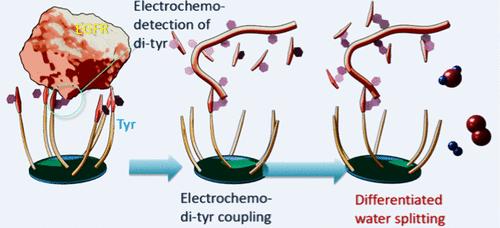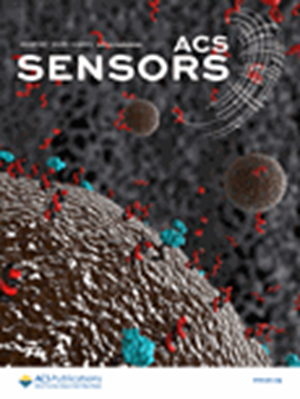Target-Induced On-Protein Clustering of Metal Peptide Enables Low Overpotential Water Splitting for Early Detection of Non-Small-Cell Lung Cancer
IF 8.2
1区 化学
Q1 CHEMISTRY, ANALYTICAL
引用次数: 0
Abstract
This study presents a novel method for the early detection of non-small-cell lung cancer (NSCLC) by employing target-induced on-protein clustering of metal–peptide complexes to facilitate low overpotential water splitting. The approach utilizes a designed peptide molecular probe composed of an EGFR-targeting motif and a copper-chelating tetrapeptide. Upon interaction with the epidermal growth factor receptor (EGFR) and divalent copper ions, the peptide probe forms a stable complex that undergoes on-protein clustering. This clustering significantly amplifies the electrochemical signal through enhanced dityrosine cross-linking and subsequent water splitting, achieving low overpotential for detection. The method was validated using clinical tissue samples and demonstrated improved sensitivity and specificity compared with traditional detection methods. This technique holds promise for earlier and more accurate diagnosis of NSCLC, leveraging the unique properties of metal–peptide interactions and electrochemical signal amplification.

金属肽在蛋白质上的目标诱导聚类可实现低过电位分水,用于非小细胞肺癌的早期检测
本研究提出了一种早期检测非小细胞肺癌(NSCLC)的新方法,即利用金属肽复合物的靶向诱导蛋白簇促进低过电位分水。该方法利用设计的多肽分子探针,该探针由表皮生长因子受体靶向基序和铜螯合四肽组成。肽探针与表皮生长因子受体(EGFR)和二价铜离子相互作用后,形成稳定的复合物,并在蛋白质上发生聚类。这种聚类通过增强的二酪氨酸交联和随后的水分裂显著放大了电化学信号,实现了低过电位检测。该方法使用临床组织样本进行了验证,与传统的检测方法相比,灵敏度和特异性都有所提高。这项技术利用金属肽相互作用和电化学信号放大的独特特性,有望更早、更准确地诊断 NSCLC。
本文章由计算机程序翻译,如有差异,请以英文原文为准。
求助全文
约1分钟内获得全文
求助全文
来源期刊

ACS Sensors
Chemical Engineering-Bioengineering
CiteScore
14.50
自引率
3.40%
发文量
372
期刊介绍:
ACS Sensors is a peer-reviewed research journal that focuses on the dissemination of new and original knowledge in the field of sensor science, particularly those that selectively sense chemical or biological species or processes. The journal covers a broad range of topics, including but not limited to biosensors, chemical sensors, gas sensors, intracellular sensors, single molecule sensors, cell chips, and microfluidic devices. It aims to publish articles that address conceptual advances in sensing technology applicable to various types of analytes or application papers that report on the use of existing sensing concepts in new ways or for new analytes.
 求助内容:
求助内容: 应助结果提醒方式:
应助结果提醒方式:


